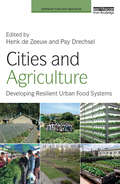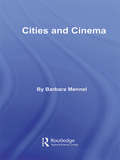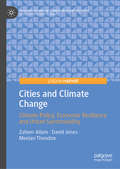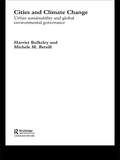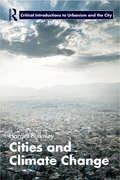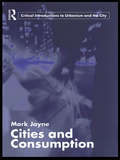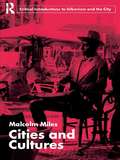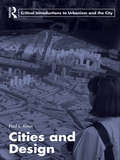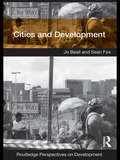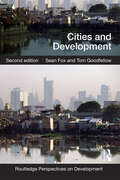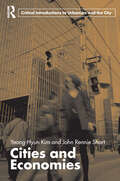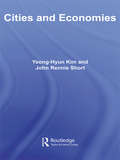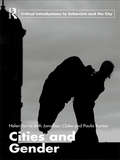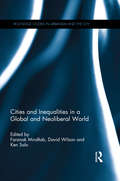- Table View
- List View
Cities and Agriculture: Developing Resilient Urban Food Systems (Earthscan Food and Agriculture)
by Henk De Zeeuw Pay DrechselAs people increasingly migrate to urban settings and more than half of the world's population now lives in cities, it is vital to plan and provide for sustainable and resilient food systems which reflect this challenge. This volume presents experience and evidence-based "state of the art" chapters on the key dimensions of urban food challenges and types of intra- and peri-urban agriculture. The book provides urban planners, local policy makers and urban development practitioners with an overview of crucial aspects of urban food systems based on an up to date review of research results and practical experiences in both developed and developing countries. By doing so, the international team of authors provides a balanced textbook for students of the growing number of courses on sustainable agriculture, food and urban studies, as well as a solid basis for well-informed policy making, planning and implementation regarding the development of sustainable, resilient and just urban food systems.
Cities and Cinema
by Barbara MennelFilms about cities abound. They provide fantasies for those who recognize their city and those for whom the city is a faraway dream or nightmare. How does cinema rework city planners’ hopes and city dwellers’ fears of modern urbanism? Can an analysis of city films answer some of the questions posed in urban studies? What kinds of vision for the future and images of the past do city films offer? What are the changes that city films have undergone? Cities and Cinema puts urban theory and cinema studies in dialogue. The book’s first section analyzes three important genres of city films that follow in historical sequence, each associated with a particular city, moving from the city film of the Weimar Republic to the film noir associated with Los Angeles and the image of Paris in the cinema of the French New Wave. The second section discusses socio-historical themes of urban studies, beginning with the relationship of film industries and individual cities, continuing with the portrayal of war torn and divided cities, and ending with the cinematic expression of utopia and dystopia in urban science fiction. The last section negotiates the question of identity and place in a global world, moving from the portrayal of ghettos and barrios to the city as a setting for gay and lesbian desire, to end with the representation of the global city in transnational cinematic practices. The book suggests that modernity links urbanism and cinema. It accounts for the significant changes that city film has undergone through processes of globalization, during which the city has developed from an icon in national cinema to a privileged site for transnational cinematic practices. It is a key text for students and researchers of film studies, urban studies and cultural studies.
Cities and Cinema
by Barbara MennelFilms about cities abound. They provide fantasies for those who recognize their city and those for whom the city is a faraway dream or nightmare. How does cinema rework city planners’ hopes and city dwellers’ fears of modern urbanism? Can an analysis of city films answer some of the questions posed in urban studies? What kinds of vision for the future and images of the past do city films offer? What are the changes that city films have undergone? Cities and Cinema puts urban theory and cinema studies in dialogue. The book’s first section analyzes three important genres of city films that follow in historical sequence, each associated with a particular city, moving from the city film of the Weimar Republic to the film noir associated with Los Angeles and the image of Paris in the cinema of the French New Wave. The second section discusses socio-historical themes of urban studies, beginning with the relationship of film industries and individual cities, continuing with the portrayal of war torn and divided cities, and ending with the cinematic expression of utopia and dystopia in urban science fiction. The last section negotiates the question of identity and place in a global world, moving from the portrayal of ghettos and barrios to the city as a setting for gay and lesbian desire, to end with the representation of the global city in transnational cinematic practices. The book suggests that modernity links urbanism and cinema. It accounts for the significant changes that city film has undergone through processes of globalization, during which the city has developed from an icon in national cinema to a privileged site for transnational cinematic practices. It is a key text for students and researchers of film studies, urban studies and cultural studies.
Cities and Cinema (Routledge Critical Introductions to Urbanism and the City)
by Barbara MennelThe second edition of Cities and Cinema provides an updated survey of films about cities, from their significance for modernity at the beginning of the twentieth century to the contemporary relationship between virtual reality and urban space. The book demonstrates the importance of the filmic depiction of capitals for national cinemas in the twentieth century and analyzes the transnational transfer of cinematic images surrounding global cities in the twenty-first century. Cities and Cinema covers the different facets of the cinematic depiction of cities. It rehearses distinct methodologies and offers a survey of the history of the cinematic city. The book also deepens our understanding of tropes and narrative conventions that shape films about urban settings and that reflect the transformation of cities throughout the twentieth and twenty-first centuries. Beginning with a discussion of the Weimar “street film,” it analyzes how the city film defined modernity. The book outlines the sociological context and the aesthetic features of so-called film noir, made in 1940s Hollywood and depicting Los Angeles. Paris became the site for the development of auteur cinema, which repeatedly depicts characters moving through the city. Tokyo took up noir to signal modern crime. The volume delineates how filmic genres, such as science fiction, comment on the present by imagining future forms of urban living. After analyzing how cinema captures the relationship between sexual identity and urban anonymity, migration and urban space, and marginalized ethnic and sexual identity in ghetto films, the book emphasizes transnational dynamics and global cities in the twenty-first century. Its conclusion points to the increasing virtual mediation of cities with new media. Cities and Cinema offers a historical overview of the development of films about cities and a theoretical approach to the intersection of urban studies and film studies. This title is designed as a textbook primarily for second-year undergraduate students in Film/Media studies, Urban studies, as well as Geography and Planning.
Cities and Cinema (Routledge Critical Introductions to Urbanism and the City)
by Barbara MennelThe second edition of Cities and Cinema provides an updated survey of films about cities, from their significance for modernity at the beginning of the twentieth century to the contemporary relationship between virtual reality and urban space. The book demonstrates the importance of the filmic depiction of capitals for national cinemas in the twentieth century and analyzes the transnational transfer of cinematic images surrounding global cities in the twenty-first century. Cities and Cinema covers the different facets of the cinematic depiction of cities. It rehearses distinct methodologies and offers a survey of the history of the cinematic city. The book also deepens our understanding of tropes and narrative conventions that shape films about urban settings and that reflect the transformation of cities throughout the twentieth and twenty-first centuries. Beginning with a discussion of the Weimar “street film,” it analyzes how the city film defined modernity. The book outlines the sociological context and the aesthetic features of so-called film noir, made in 1940s Hollywood and depicting Los Angeles. Paris became the site for the development of auteur cinema, which repeatedly depicts characters moving through the city. Tokyo took up noir to signal modern crime. The volume delineates how filmic genres, such as science fiction, comment on the present by imagining future forms of urban living. After analyzing how cinema captures the relationship between sexual identity and urban anonymity, migration and urban space, and marginalized ethnic and sexual identity in ghetto films, the book emphasizes transnational dynamics and global cities in the twenty-first century. Its conclusion points to the increasing virtual mediation of cities with new media. Cities and Cinema offers a historical overview of the development of films about cities and a theoretical approach to the intersection of urban studies and film studies. This title is designed as a textbook primarily for second-year undergraduate students in Film/Media studies, Urban studies, as well as Geography and Planning.
Cities and Climate Change: Climate Policy, Economic Resilience and Urban Sustainability (Palgrave Studies in Climate Resilient Societies)
by Zaheer Allam David Jones Meelan ThondooThis book explores climate change responsiveness policies for cities and discusses why they have been slow to gain traction despite having been on the international agenda for the last 30 years. The contributing role of cities in accentuating the effects of climate change is increasingly demonstrated in the literature, underscoring the unsustainable models on which urban life has been made to thrive. As these issues become increasingly apparent, there are global calls to adopt more sustainable and equitable models, however doing so will mean the disruption of economies that have historically relied upon pollution-generating industries. In order to address these issues the authors examine them from a cross-disciplinary perspective, bringing in regional, local and urban standpoints to subsequently propose an alternative short-term economic model that could accelerate the adoption of climate change mitigation infrastructures and urban sustainability in urban areas. This book will be of particular value to scholars and students alike in the field of urbanism, sustainability and resilience, as well as practitioners looking at avenues for economically incentivizing sustainable development in various geographical context.
Cities and Climate Change (Routledge Studies in Physical Geography and Environment)
by Michelle Betsill Harriet BulkeleyClimate change is one of the most challenging issues of our time. As key sites in the production and management of emissions of greenhouse gases, cities will be crucial for the implementation of international agreements and national policies on climate change. This book provides a critical analysis of the role of cities in addressing climate change and the prospects for urban sustainability. Cities and Climate Change is the first in-depth analysis of the role of cities in addressing climate change. The book argues that key challenges concerning the resources and powers of local government, as well as conflicts between local goals for economic development and climate change mitigation, have restricted the level of local action on climate change. These findings have significant implications for the prospects of mitigating climate change and achieving urban sustainability. This book provides a valuable interdisciplinary analysis of these issues, and will appeal to students and researchers interested in sustainability at local and global scales.
Cities and Climate Change (Routledge Studies in Physical Geography and Environment)
by Michelle Betsill Harriet BulkeleyClimate change is one of the most challenging issues of our time. As key sites in the production and management of emissions of greenhouse gases, cities will be crucial for the implementation of international agreements and national policies on climate change. This book provides a critical analysis of the role of cities in addressing climate change and the prospects for urban sustainability. Cities and Climate Change is the first in-depth analysis of the role of cities in addressing climate change. The book argues that key challenges concerning the resources and powers of local government, as well as conflicts between local goals for economic development and climate change mitigation, have restricted the level of local action on climate change. These findings have significant implications for the prospects of mitigating climate change and achieving urban sustainability. This book provides a valuable interdisciplinary analysis of these issues, and will appeal to students and researchers interested in sustainability at local and global scales.
Cities and Climate Change
by Harriet BulkeleyClimate change is one of the most significant global challenges facing the world today. It is also a critical issue for the world’s cities. Now home to over half the world’s population, urban areas are significant sources of greenhouse gas emissions and are vulnerable to the impacts of climate change. Responding to climate change is a profound challenge. A variety of actors are involved in urban climate governance, with municipal governments, international organisations, and funding bodies pointing to cities as key arenas for response. This book provides the first critical introduction to these challenges, giving an overview of the science and policy of climate change at the global level and the emergence of climate change as an urban policy issue. It considers the challenges of governing climate change in the city in the context of the changing nature of urban politics, economics, society and infrastructures. It looks at how responses for mitigation and adaptation have emerged within the city, and the implications of climate change for social and environmental justice. Drawing on examples from cities in the north and south, and richly illustrated with detailed case-studies, this book will enable students to understand the potential and limits of addressing climate change at the urban level and to explore the consequences for our future cities. It will be essential reading for undergraduate students across the disciplines of geography, politics, sociology, urban studies, planning and science and technology studies.
Cities and Climate Change
by Harriet BulkeleyClimate change is one of the most significant global challenges facing the world today. It is also a critical issue for the world’s cities. Now home to over half the world’s population, urban areas are significant sources of greenhouse gas emissions and are vulnerable to the impacts of climate change. Responding to climate change is a profound challenge. A variety of actors are involved in urban climate governance, with municipal governments, international organisations, and funding bodies pointing to cities as key arenas for response. This book provides the first critical introduction to these challenges, giving an overview of the science and policy of climate change at the global level and the emergence of climate change as an urban policy issue. It considers the challenges of governing climate change in the city in the context of the changing nature of urban politics, economics, society and infrastructures. It looks at how responses for mitigation and adaptation have emerged within the city, and the implications of climate change for social and environmental justice. Drawing on examples from cities in the north and south, and richly illustrated with detailed case-studies, this book will enable students to understand the potential and limits of addressing climate change at the urban level and to explore the consequences for our future cities. It will be essential reading for undergraduate students across the disciplines of geography, politics, sociology, urban studies, planning and science and technology studies.
Cities and Consumption (Routledge Critical Introductions to Urbanism and the City)
by Mark JayneIn investigating the mutual and dynamic relationship between urban development and consumption, this book asks: how are cities moulded by consumption, and how is consumption moulded by cities? Consumption stands at the intersection of different spheres of everyday life: between the public and the private, the political and the personal, the individual and the social. It is considered to be a means and motor of social change; as an active ingredient in the construction of space and place, and in constructing subjectivity and social selfhood. Providing a critical review of the ways in which urban development has been conceptualized, this book critiques urban regeneration initiatives, examines ordinary and spectacular consumption, and describes the relationship between consumption and development of the modern and post-modern city. It investigates: consumption and the city consumption and everyday life consumption, cities and identity consumption and urban regeneration. Consumption is understood to have multiple roles as a political, economic and cultural touchstone, and to be an active ingredient in the construction of place and space. Using international case studies and illustrations throughout, this book thoroughly analyzes consumption and the city, and provides a useful text for students of urban studies, sociology and geography.
Cities and Consumption (Routledge Critical Introductions to Urbanism and the City)
by Mark JayneIn investigating the mutual and dynamic relationship between urban development and consumption, this book asks: how are cities moulded by consumption, and how is consumption moulded by cities? Consumption stands at the intersection of different spheres of everyday life: between the public and the private, the political and the personal, the individual and the social. It is considered to be a means and motor of social change; as an active ingredient in the construction of space and place, and in constructing subjectivity and social selfhood. Providing a critical review of the ways in which urban development has been conceptualized, this book critiques urban regeneration initiatives, examines ordinary and spectacular consumption, and describes the relationship between consumption and development of the modern and post-modern city. It investigates: consumption and the city consumption and everyday life consumption, cities and identity consumption and urban regeneration. Consumption is understood to have multiple roles as a political, economic and cultural touchstone, and to be an active ingredient in the construction of place and space. Using international case studies and illustrations throughout, this book thoroughly analyzes consumption and the city, and provides a useful text for students of urban studies, sociology and geography.
Cities and Cultures
by Malcolm MilesCities and Cultures is a critical account of the relations between contemporary cities and the cultures they produce and which in turn shape them. The book questions received ideas of what constitutes a city's culture through case studies in which different kinds of culture - the arts, cultural institutions and heritage, distinctive ways of life - are seen to be differently used in or affected by the development of particular cities. The book does not mask the complexity of this, but explains it in ways accessible for undergraduates. The book begins with introductory chapters on the concepts of a city and a culture (the latter in the anthropological sense as well as denoting the arts), citing cases from modern literature. The book then moves from a critical account of cultural production in a metropolitan setting to the idea that a city, too, is produced through the characteristic ways of life of its inhabitants. The cultural industries are scrutinised for their relation to such cultures as well as to city marketing, and attention is given to the European Cities of Culture initiative, and to the hybridity of contemporary urban cultures in a period of globalisation and migration. In its penultimate chapter the book looks at incidental cultural forms and cultural means to identify formation; and in its final chapter, examines the permeability of urban cultures and cultural forms. Sources are introduced, positions clarified and contrasted, and notes given for selective further reading. Playing on the two meanings of culture, Miles takes an unique approach by relating arguments around these meanings to specific cases of urban development today. The book includes both critical comment on a range of literatures - being a truly inter-disciplinary study - and the outcome of the author's field research into urban cultures.
Cities and Cultures
by Malcolm MilesCities and Cultures is a critical account of the relations between contemporary cities and the cultures they produce and which in turn shape them. The book questions received ideas of what constitutes a city's culture through case studies in which different kinds of culture - the arts, cultural institutions and heritage, distinctive ways of life - are seen to be differently used in or affected by the development of particular cities. The book does not mask the complexity of this, but explains it in ways accessible for undergraduates. The book begins with introductory chapters on the concepts of a city and a culture (the latter in the anthropological sense as well as denoting the arts), citing cases from modern literature. The book then moves from a critical account of cultural production in a metropolitan setting to the idea that a city, too, is produced through the characteristic ways of life of its inhabitants. The cultural industries are scrutinised for their relation to such cultures as well as to city marketing, and attention is given to the European Cities of Culture initiative, and to the hybridity of contemporary urban cultures in a period of globalisation and migration. In its penultimate chapter the book looks at incidental cultural forms and cultural means to identify formation; and in its final chapter, examines the permeability of urban cultures and cultural forms. Sources are introduced, positions clarified and contrasted, and notes given for selective further reading. Playing on the two meanings of culture, Miles takes an unique approach by relating arguments around these meanings to specific cases of urban development today. The book includes both critical comment on a range of literatures - being a truly inter-disciplinary study - and the outcome of the author's field research into urban cultures.
Cities and Design
by Paul L. KnoxCities, initially a product of the manufacturing era, have been thoroughly remade in the image of consumer society. Competitive spending among affluent households has intensified the importance of style and design at every scale and design professions have grown in size and importance, reflecting distinctive geographies and locating disproportionately in cities most intimately connected with global systems of key business services. Meanwhile, many observers still believe good design can make positive contributions to people’s lives. Cities and Design explores the complex relationships between design and urban environments. It traces the intellectual roots of urban design, presents a critical appraisal of the imprint and effectiveness of design professions in shaping urban environments, examines the role of design in the material culture of contemporary cities, and explores the complex linkages among designers, producers and distributors in contemporary cities, for example: fashion and graphic design in New York; architecture, fashion and publishing in London; furniture, industrial design, interior design and fashion in Milan; haute couture in Paris and so on. This book offers a distinctive social science perspective on the economic and cultural context of design in contemporary cities, presenting cities themselves as settings for design, design services and the ‘affect’ associated with design.
Cities and Design
by Paul L. KnoxCities, initially a product of the manufacturing era, have been thoroughly remade in the image of consumer society. Competitive spending among affluent households has intensified the importance of style and design at every scale and design professions have grown in size and importance, reflecting distinctive geographies and locating disproportionately in cities most intimately connected with global systems of key business services. Meanwhile, many observers still believe good design can make positive contributions to people’s lives. Cities and Design explores the complex relationships between design and urban environments. It traces the intellectual roots of urban design, presents a critical appraisal of the imprint and effectiveness of design professions in shaping urban environments, examines the role of design in the material culture of contemporary cities, and explores the complex linkages among designers, producers and distributors in contemporary cities, for example: fashion and graphic design in New York; architecture, fashion and publishing in London; furniture, industrial design, interior design and fashion in Milan; haute couture in Paris and so on. This book offers a distinctive social science perspective on the economic and cultural context of design in contemporary cities, presenting cities themselves as settings for design, design services and the ‘affect’ associated with design.
Cities and Development
by Jo Beall Sean FoxBy 2030 more than sixty percent of the world's population will live in urban areas, with most of the world’s population growth over the next twenty-five years being absorbed by cities and towns in low and middle income countries. What are the consequences of this shift? Demographic pressure already strains the capacity of local and national governments to manage urban change. Today, nearly one billion people live in slums, and in the absence of significant intervention that number is set to double in the next two decades. Will our future be dominated by mega-cities of poverty and despair, or can urbanization be harnessed to advance human and economic development? Cities and Development provides a critical exploration of the dynamic relationship between urbanism and development. Highlighting both the challenges and opportunities associated with rapid urban change, the book surveys: the historical relationship between urbanization and development the role cities play in fostering economic growth in a globalizing world the unique characteristics of urban poverty and the poor record of interventions designed to tackle it the complexities of managing urban environments; issues of urban crime, violence, war and terrorism in contemporary cities the importance of urban planning, governance and politics in shaping city futures. This book brings into conversation debates from urban and development studies and highlights the strengths and weaknesses of current policy and planning responses to the contemporary urban challenge. It includes research orientated supplements in the form of summaries, boxed case studies, development questions and further reading. The book is intended for senior undergraduate and graduate students interested in urban, international and development studies, as well as policy-makers and planners concerned with equitable and sustainable urban development.
Cities and Development
by Jo Beall Sean FoxBy 2030 more than sixty percent of the world's population will live in urban areas, with most of the world’s population growth over the next twenty-five years being absorbed by cities and towns in low and middle income countries. What are the consequences of this shift? Demographic pressure already strains the capacity of local and national governments to manage urban change. Today, nearly one billion people live in slums, and in the absence of significant intervention that number is set to double in the next two decades. Will our future be dominated by mega-cities of poverty and despair, or can urbanization be harnessed to advance human and economic development? Cities and Development provides a critical exploration of the dynamic relationship between urbanism and development. Highlighting both the challenges and opportunities associated with rapid urban change, the book surveys: the historical relationship between urbanization and development the role cities play in fostering economic growth in a globalizing world the unique characteristics of urban poverty and the poor record of interventions designed to tackle it the complexities of managing urban environments; issues of urban crime, violence, war and terrorism in contemporary cities the importance of urban planning, governance and politics in shaping city futures. This book brings into conversation debates from urban and development studies and highlights the strengths and weaknesses of current policy and planning responses to the contemporary urban challenge. It includes research orientated supplements in the form of summaries, boxed case studies, development questions and further reading. The book is intended for senior undergraduate and graduate students interested in urban, international and development studies, as well as policy-makers and planners concerned with equitable and sustainable urban development.
Cities and Development (Routledge Perspectives on Development)
by Sean Fox Tom GoodfellowFor the first time in human history more people now live and towns and cities than in rural areas. In the wealthier countries of the world, the transition from predominantly rural to urban habitation is more or less complete. But in many parts of Africa, Asia and Latin America, urban populations are expanding rapidly. Current UN projections indicate that virtually all population growth in the world over the next 30 years will be absorbed by towns and cities in developing countries. These simple demographic facts have profound implications for those concerned with understanding and addressing the pressing global development challenges of reducing poverty, promoting economic growth, improving human security and confronting environmental change. This revised and expanded second edition of Cities and Development explores the dynamic relationship between urbanism and development from a global perspective. The book surveys a wide range of topics, including: the historical origins of world urbanization; the role cities play in the process of economic development; the nature of urban poverty and the challenge of promoting sustainable livelihoods; the complexities of managing urban land, housing, infrastructure and urban services; and the spectres of endemic crime, conflict and violence in urban areas. This updated volume also contains two entirely new chapters: one that examines the links between urbanisation and environmental change, and a second that focuses on urban governance and politics. Adopting a multidisciplinary perspective, the book critically engages with debates in urban studies, geography and international development studies. Each chapter includes supplements in the form of case studies, chapter summaries, questions for discussion and suggested further readings. The book is targeted at upper-level undergraduate and graduate students interested in geography, urban studies and international development studies, as well as policy makers, urban planners and development practitioners.
Cities and Development (Routledge Perspectives on Development)
by Sean Fox Tom GoodfellowFor the first time in human history more people now live and towns and cities than in rural areas. In the wealthier countries of the world, the transition from predominantly rural to urban habitation is more or less complete. But in many parts of Africa, Asia and Latin America, urban populations are expanding rapidly. Current UN projections indicate that virtually all population growth in the world over the next 30 years will be absorbed by towns and cities in developing countries. These simple demographic facts have profound implications for those concerned with understanding and addressing the pressing global development challenges of reducing poverty, promoting economic growth, improving human security and confronting environmental change. This revised and expanded second edition of Cities and Development explores the dynamic relationship between urbanism and development from a global perspective. The book surveys a wide range of topics, including: the historical origins of world urbanization; the role cities play in the process of economic development; the nature of urban poverty and the challenge of promoting sustainable livelihoods; the complexities of managing urban land, housing, infrastructure and urban services; and the spectres of endemic crime, conflict and violence in urban areas. This updated volume also contains two entirely new chapters: one that examines the links between urbanisation and environmental change, and a second that focuses on urban governance and politics. Adopting a multidisciplinary perspective, the book critically engages with debates in urban studies, geography and international development studies. Each chapter includes supplements in the form of case studies, chapter summaries, questions for discussion and suggested further readings. The book is targeted at upper-level undergraduate and graduate students interested in geography, urban studies and international development studies, as well as policy makers, urban planners and development practitioners.
Cities and Economies
by Yeong-Hyun Kim John Rennie ShortCities and Economies explores the complex and subtle connections between cities and economies. The rise of the merchant city, the development of the industrial city and the creation of the service-dominated urban economy are all explored, along with economic globalization and its effects on cities in both developed and developing economies. This book provides a thorough examination of the role of the city in shaping economic processes and explains the different effects that economies have on cities. It provides an invaluable and unrivaled guide to the relationship between urban structure and economic processes as they compare and contrast across the world. The authors examine the complex relationships between the city and the economy in historical and global contexts, as well as evaluating the role of world cities, the economic impacts of megacities and the role of the state in shaping urban economic policies. They focus on the ways in which cities have led, and at the same time adapted to, economic shifts. Large cities are viewed as the centres of regional and national economies, while a small number are defined by their centrality in the global economy. The book: examines key ideas and concepts on the economic aspects of urban change explores the changing nature of urban economies and their relationships with changes at the national and global levels compares current economic issues and policies of large cities around the world explores the links between globalization and economic changes in cities and the growing competitions between them. Cities and Economies uses case studies, photographs and maps expanding across the US, Western Europe and Asia. Written in a clear and accessible style, the book answers some fundamental questions about the economic role of cities. It is an essential text for students of geography, economics, sociology, urban studies and urban planning.
Cities and Economies
by Yeong-Hyun Kim John Rennie ShortCities and Economies explores the complex and subtle connections between cities and economies. The rise of the merchant city, the development of the industrial city and the creation of the service-dominated urban economy are all explored, along with economic globalization and its effects on cities in both developed and developing economies. This book provides a thorough examination of the role of the city in shaping economic processes and explains the different effects that economies have on cities. It provides an invaluable and unrivaled guide to the relationship between urban structure and economic processes as they compare and contrast across the world. The authors examine the complex relationships between the city and the economy in historical and global contexts, as well as evaluating the role of world cities, the economic impacts of megacities and the role of the state in shaping urban economic policies. They focus on the ways in which cities have led, and at the same time adapted to, economic shifts. Large cities are viewed as the centres of regional and national economies, while a small number are defined by their centrality in the global economy. The book: examines key ideas and concepts on the economic aspects of urban change explores the changing nature of urban economies and their relationships with changes at the national and global levels compares current economic issues and policies of large cities around the world explores the links between globalization and economic changes in cities and the growing competitions between them. Cities and Economies uses case studies, photographs and maps expanding across the US, Western Europe and Asia. Written in a clear and accessible style, the book answers some fundamental questions about the economic role of cities. It is an essential text for students of geography, economics, sociology, urban studies and urban planning.
Cities and Gender (Routledge Critical Introductions to Urbanism and the City)
by Helen Jarvis Jonathan Cloke Paula KantorMen and women experience the city differently: in relation to housing assets, use of transport, relative mobility, spheres of employment and a host of domestic and caring responsibilities. An analysis of urban and gender studies, as co-constitutive subjects, is long overdue. Cities and Gender is a systematic treatment of urban and gender studies combined. It presents both a feminist critique of mainstream urban policy and planning and a gendered reorientation of key urban social, environmental and city-regional debates. It looks behind the ‘headlines’ on issues of transport, housing, uneven development, regeneration and social exclusion, for instance, to account for the ‘hidden’ infrastructure of everyday life. The three main sections on 'Approaching the City', 'Gender and Built Environment' and, finally, 'Representation and Regulation' explore not only the changing environments, working practices and household structures evident in European and North American cities today, but also those of the global south. International case studies alert the reader to stark contrasts in gendered life-chances (differences between north and south as well as inequalities and diversity within these regions) while at the same time highlighting interdependencies which globally thread through the lives of women and men as the result of uneven development. This book introduces the reader to previously neglected dimensions of gendered critical urban analysis. It sheds light, through competing theories and alternative explanations, on recent transformations of gender roles, state and personal politics and power relations; across intersecting spheres: of home, work, the family, urban settlements and civil society. It takes a household perspective alongside close scrutiny of social networks, gender contracts, welfare regimes and local cultural milieu. In addition to providing the student with a solid conceptual grounding across broad structures of production, consumption and social reproduction, the argument cultivates an interdisciplinary awareness of, and dialogue between, the everyday issues of urban dwellers in affluent and developing world cities. The format of the book means that included with each chapter are key definitions, ‘boxed’ concepts and case study evidence along with specifically tailored learning activities and further reading. This is both a timely and trenchant discussion that has pertinence for students, scholars and researchers.
Cities and Gender (Routledge Critical Introductions to Urbanism and the City)
by Helen Jarvis Jonathan Cloke Paula KantorMen and women experience the city differently: in relation to housing assets, use of transport, relative mobility, spheres of employment and a host of domestic and caring responsibilities. An analysis of urban and gender studies, as co-constitutive subjects, is long overdue. Cities and Gender is a systematic treatment of urban and gender studies combined. It presents both a feminist critique of mainstream urban policy and planning and a gendered reorientation of key urban social, environmental and city-regional debates. It looks behind the ‘headlines’ on issues of transport, housing, uneven development, regeneration and social exclusion, for instance, to account for the ‘hidden’ infrastructure of everyday life. The three main sections on 'Approaching the City', 'Gender and Built Environment' and, finally, 'Representation and Regulation' explore not only the changing environments, working practices and household structures evident in European and North American cities today, but also those of the global south. International case studies alert the reader to stark contrasts in gendered life-chances (differences between north and south as well as inequalities and diversity within these regions) while at the same time highlighting interdependencies which globally thread through the lives of women and men as the result of uneven development. This book introduces the reader to previously neglected dimensions of gendered critical urban analysis. It sheds light, through competing theories and alternative explanations, on recent transformations of gender roles, state and personal politics and power relations; across intersecting spheres: of home, work, the family, urban settlements and civil society. It takes a household perspective alongside close scrutiny of social networks, gender contracts, welfare regimes and local cultural milieu. In addition to providing the student with a solid conceptual grounding across broad structures of production, consumption and social reproduction, the argument cultivates an interdisciplinary awareness of, and dialogue between, the everyday issues of urban dwellers in affluent and developing world cities. The format of the book means that included with each chapter are key definitions, ‘boxed’ concepts and case study evidence along with specifically tailored learning activities and further reading. This is both a timely and trenchant discussion that has pertinence for students, scholars and researchers.
Cities and Inequalities in a Global and Neoliberal World (Routledge Studies in Urbanism and the City)
by David Wilson Faranak Miraftab Ken SaloCities continue to be key sites for the production and contestation of inequalities generated by an ongoing but troubled neoliberal project. Neoliberalism’s onslaught across the globe now shapes diverse inequalities -- poverty, segregation, racism, social exclusion, homelessness -- as city inhabitants feel the brunt of privatization, state re-organization, and punishing social policy. This book examines the relationship between persistent neoliberalism and the production and contestation of inequalities in cities across the world. Case studies of current city realities reveal a richly place-specific and generalizable neoliberal condition that further deepens the economic, social, and political relations that give rise to diverse inequalities. Diverse cases also show how people struggle against a neoliberal ethos and hence the open-endedness of futures in these cities.
